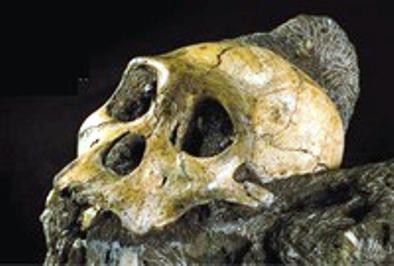Four Individuals Caught in 'Death Trap' May Shed Light on Human Ancestors
Ann Gibbons
Source - http://news.sciencemag.org/sciencenow/2011/04/four-individuals-caught-in-death.html?ref=hp

Surprising mix. The skull and bones of Au. sediba have an unusual mix of modern and primitive traits. Credit: L. Berger et al., Science
Finding one partial skeleton of an ancient member of the human family is the rarest of rare discoveries in human evolution. So, paleoanthropologists murmured in surprise at a meeting here Saturday when South African researchers announced that they had found at least four individuals of a new species of early human, Australopithecus sediba. The discoverers say that this hominin shows some surprisingly modern traits and its species may even be an ancestor of our own genus. “We really have found something very, very odd and very unexpected,” says discovery team leader Lee Berger of the University of the Witwatersrand in Johannesburg, South Africa. But other paleoanthropologists are waiting for more detailed analysis of the still-unpublished fossils before they agree on its identity or place in the human family tree.
The four hominin individuals died when they fell into a “death trap” in a cave about 2 million years ago at Malapa, South Africa, according to new dates reported by Berger in his talk at the annual meeting of the American Association of Physical Anthropologists (AAPA). In addition to the articulated partial skeletons of a youth and an older female unveiled last year in Science, the team members reported the discovery of bones of an 18-month-old infant and at least one other adult. This means they are getting a good look at Au. sediba’s development from infancy to old age. “It is going to be a remarkable record,” Berger said. “And we still haven’t found everything!”
In talks at AAPA and the annual meeting of the Paleoanthropology Society last week, Berger and members of his team sketched a quick portrait of Au. sediba, who lived at the mysterious time right after the emergence of our genus Homo between 2 million to 3 million years ago. Researchers have long wondered which of several species of Australopithecus gave rise to the first members of our genus, with Lucy’s species Au. afarensis as the leading candidate.
The trove of well-preserved bones includes clavicles, shoulder blades, and ribs as well as a complete skull, hand, foot, and two pelvises. The researchers called it an australopithecine—extinct members of the human family that lived 1 million to 4 million years ago in Africa—because it had a small brain the size of an ape's, and its “overall body plan” was like that of an australopithecine, team member Darryl de Ruiter of Texas A&M University in College Station said in a talk. It had long arms and a primitive thorax and heel like an ape, for example.
But the fossils also show some surprisingly modern traits usually found only in members of our own genus, Berger said. Two pelvises, in particular, are capacious and elongated in a way that looks quite Homo-like. In his talk on the fossils, Berger ticked off a list of other traits that were modern, including smaller teeth, short fingers, and an elongated thumb.
In a separate talk at the Paleoanthropology Society, Kristian Carlson of Indiana University, Bloomington, described the endocast, the impression left inside the skull by the brain. He said that the outer surface of the brain suggests that the forebrain, the uppermost part of the brain that extends from the forehead to the base of the skull, might be reorganized in a modern way. If so, Au. sediba’s brain and pelvis would have both begun to evolve into more modern shapes before the brain expanded—countering the view that the expanding brain drove the remodeling of the pelvis to accommodate bigger-brained babies.
These particular individuals could not be ancestors of Homo because members of our genus were already living at the time when these hominins fell into the pit at Malapa. But, Berger says, they might be late members of the australopithecine species that gave rise to Homo earlier, or a close relative that could shed light on that crucial ancestor.
Other researchers, who were able to examine casts of the fossils at the meeting, agreed that on first glance the fossils represent an unusual mix of primitive and more modern traits. But most thought it important to compare Au. sediba directly with other fossils of early Homo and Australopithecus in more detail before placing them on our family tree. “The pelvis does look more modern,” says paleoanthropologist Christopher Ruff of Johns Hopkins University in Baltimore, Maryland. “But that doesn’t mean it looks exactly like a modern human’s or that it gave rise to early Homo.”
Yet even if Au. sediba is an evolutionary dead end, William Kimbel of Arizona State University in Tempe says, “It does still shed light on the evolution of early Homo because we know nothing about the time period 1/2 million to 3/4 million years before Au. sediba.”